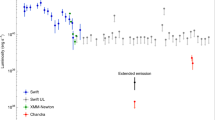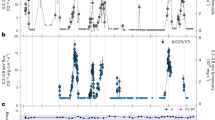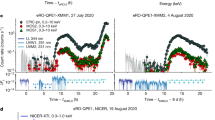Abstract
The possibility that point X-ray sources possess extended haloes arising from scattering of X rays by interstellar grains has been discussed by several authors (see, for example, refs 1, 2) and recent observations using the Einstein X-ray satellite have suggested that observational evidence for such haloes is now becoming available. For example, Rolf3 has shown that the X-ray source GX 339–4 has a discernible halo out to ∼20 arc min, while Catura4 has argued that several low latitude X-ray sources may have haloes that extend to ≳10 arc min. Much of the theoretical work on such haloes to date has involved steady (time-independent) X-ray sources. While haloes around such sources can provide useful information about the scattering medium, variable X-ray sources are potentially much more powerful probes of the interstellar dust distribution5,6. We discuss here the scattering of soft X rays emitted by dwarf novae in outburst, during which these objects undergo short (∼1 day) eruption at soft X-ray wavelengths7,8. We also consider the nature of the apparently transient soft X-ray ‘ring’ around the dwarf nova SU UMa (ref. 9) and we show that the properties of such a ring are consistent with those expected from the effect under consideration.
This is a preview of subscription content, access via your institution
Access options
Subscribe to this journal
Receive 51 print issues and online access
$199.00 per year
only $3.90 per issue
Buy this article
- Purchase on Springer Link
- Instant access to full article PDF
Prices may be subject to local taxes which are calculated during checkout
Similar content being viewed by others
References
Hayakawa, S. Prog. theor. Phys. 43, 1224–1230 (1970).
Overbeck, J. W. Astrophys. J. 141, 864–866 (1965).
Rolf, D. Nature 302, 46–48 (1983).
Catura, R. C. Bull. Am. astr. Soc. 14, 893 (1983).
Trümper, J. & Schönfelder, U. Astr. Astrophys. 25, 445–450 (1973).
Alcock, C. & Hatchett, S. Astrophys. J. 222, 456–470 (1978).
Cordova, F. A., Nugent, J. J., Klein, S. R. & Garmire, G. P. Mon. Not. R. astr. Soc. 190, 87–97 (1980).
Mason, K. O., Lampton, M., Charles, P. & Bowyer, S. Astrophys. J. 226, L129–L132 (1978).
Cordova, F. A. & Mason, K. O. Nature 287, 25–27 (1980).
Allen, C. W. Astrophysical Quantities 3rd ed, 265 (Athlone, London, 1973).
Szkody, P. Astrophys. J. 247, 577–589 (1981).
Bode, M. F., Evans, A. & Bruch, A. Proc. IAU Colloq. 69, 475–481 (1982).
Author information
Authors and Affiliations
Rights and permissions
About this article
Cite this article
Norwell, G., Evans, A. & Bode, M. Transient X-ray rings around dwarf novae. Nature 303, 49–50 (1983). https://doi.org/10.1038/303049a0
Received:
Accepted:
Issue Date:
DOI: https://doi.org/10.1038/303049a0
Comments
By submitting a comment you agree to abide by our Terms and Community Guidelines. If you find something abusive or that does not comply with our terms or guidelines please flag it as inappropriate.



